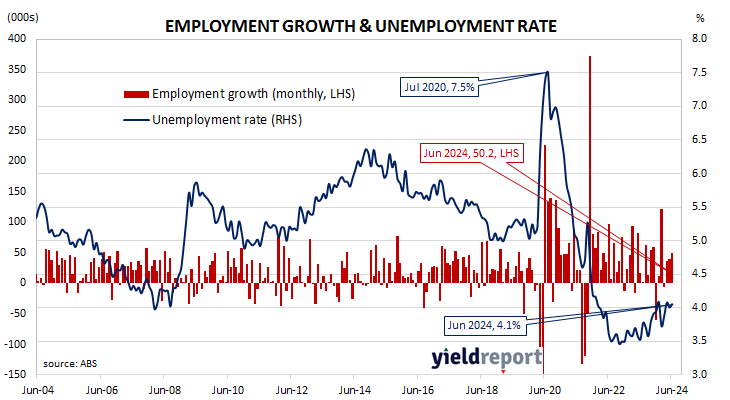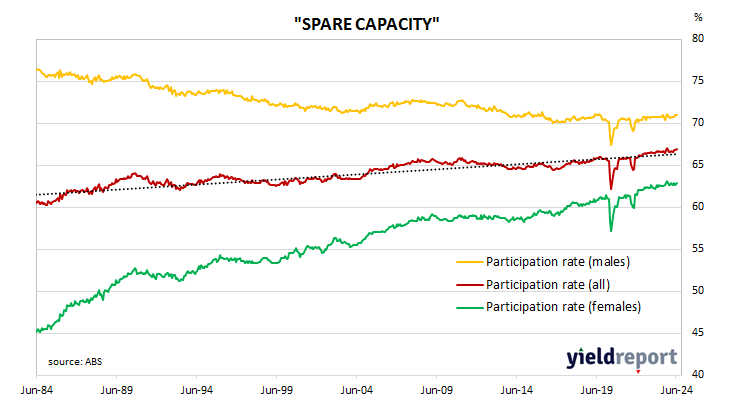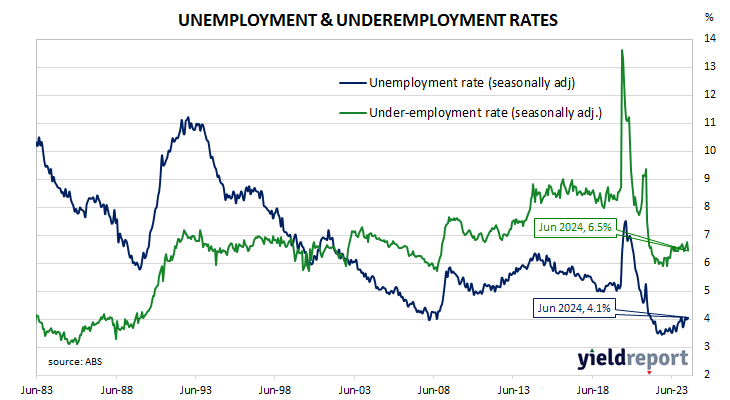Summary: Employment up 50,200 in June, greater than expected; Westpac: employment growth has clearly slowed; short-term ACGB yields higher, longer-term yields slip; rate-rise expectations firm; ANZ: labour market exerting less upwards pressure on wages; participation rate ticks up to 66.9%; jobless rate rises from 4.0% to 4.1%; more part-time jobs, more full-time jobs; aggregate work hours up 0.8%; underemployment rate declines to 6.5%.
Australia’s period of falling unemployment came to an end in early 2019 when the jobless rate hit a low of 4.9%. It then averaged around 5.2% through to March 2020, bouncing around in a range from 5.1% to 5.3%. Leading indicators such as ANZ-Indeed’s Job Ads survey and NAB’s capacity utilisation estimate suggested the unemployment rate would rise in the June 2020 quarter and it did so, sharply. The jobless rate peaked in July 2020 but fell below 7% a month later and then trended lower through 2021 and 2022.
The latest Labour force figures have now been released and they indicate the number of people employed in Australia according to ABS definitions increased by 50,200 in June. The result was greater than the 39,700 rise which had been generally expected as well as May’s rise of 39,500.
“These results do not necessarily mean that the labour market is performing on a par with, or perhaps even stronger, than last year, however,” said Westpac economist Ryan Wells. “On a three-month average basis, employment growth has clearly slowed from an annual pace of 3.6% in June 2023, to 3.1% in December 2023, to 2.7% in June 2024.”
Short-term domestic Treasury bond yields finished the day modestly higher while longer-term yields slipped a touch, unlike the modest rises of US Treasury yields from the previous night. By the close of business, the 3-year ACGB yield had added 2bps to 3.95% while 10-year and 20-year yields both finished 1bp lower 4.25% and 4.59% respectively.
Expectations regarding rate rises in the next six months firmed. Cash futures prices at the end of the day implied the cash rate has some chance of rising above the current rate of 4.34% in the short-term, with an average of 4.385% in August and 4.41% in November. However, February 2025 contracts implied 4.335% and May 2025 contracts implied 4.175%, 17bps less than the current cash rate.
“Despite the employment growth in June, the labour market is continuing to slow, with the unemployment rate drifting up since late 2022 and employment and hours worked growth both slowing,” said ANZ senior economist Blair Chapman. “The labour market is now exerting less upwards pressure on wages, with wages growth appearing to have peaked last year and newly agreed enterprise bargaining agreements incorporating lower future wages growth than those agreed last year.”
The participation rate ticked up from 66.8% to 66.9% as the total available workforce increased by 59,900 to 15.014 million while the number of unemployed persons increased by 9,700 to 608,200. As a result, the unemployment rate increased from 4.0% to 4.1%.
The aggregate number of hours worked across the economy increased by 0.8% even as 6,800 residents gained part-time positions and 43,300 residents gained full-time positions. On a 12-month basis and after revisions, aggregate hours worked increased by 1.4% as 266,300 more people held part-time positions and 122,100 more people held full-time positions than in June 2023.
More attention has been paid to the underemployment rate in recent years, which is the number of people in work but who wish to work more hours than they do currently. June’s underemployment rate declined from 6.7% to 6.5%, 0.6 percentage points above this cycle’s low.
The underutilisation rate, that is the sum of the underemployment rate and the unemployment rate, has a strong correlation with the annual growth rate of the ABS private sector wage index when advanced by two quarters. June’s underutilisation rate of 10.5% corresponds with an annual growth rate of about 4.0%.




